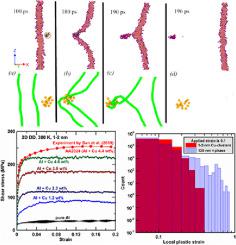International Journal of Plasticity ( IF 9.8 ) Pub Date : 2021-08-19 , DOI: 10.1016/j.ijplas.2021.103095 E.V. Fomin 1 , A.E. Mayer 1, 2 , V.S. Krasnikov 1, 2

|
We investigate the deformation of aluminum alloy containing copper in the form of fine Al-Cu clusters 1–4 nm in diameter with multiscale approach. A part of these precipitates (clusters of 1–2 nm in diameter) reproduce that were experimentally obtained by (Sun et al., 2019) by cyclic dynamic loading of aluminum alloy. At the first stage, molecular dynamics (MD) reveals that main mechanism of interaction of dislocation with the copper-containing cluster are cutting of precipitate for 1 nm cluster and bypass by Orowan mechanism for clusters with diameters above 1.4 nm. Single events of climb are observed in MD, frequency of which increases with a temperature raise. The stresses level realized for the climb mechanism practically do not differ from that of the basic mechanism for the considered inclusion diameters. Also, the results of MD simulations show that the strength of the cluster depends on the presence of enough number of copper atoms on the slip plane of dislocation and does not directly depend on the concentration of copper when it varies in the range of 20–100% inside the precipitate. Reduction of copper concentration below 20% decreases the precipitate resistance, and the system behavior converges to the case of pure aluminum at 0%. These results are supported by MD calculations of generalized stacking fault energy, which demonstrate a weak dependence of unstable stacking fault energy on copper concentration in the range of 30–70%. A continuum model of dislocation motion in aluminum containing the copper-containing cluster is proposed, which considers the kinetics of dislocation-precipitate interaction and accounts for the transition from cutting to bypass. Parameters of the model are fitted to MD data with Bayesian algorithm. Model of dislocation motion and dislocation-precipitate interaction is implemented into 2D discrete-dislocation dynamics (DDD). Flow stress of alloy predicted with DDD demonstrates reasonable agreement with the experimental data. Calculations show that the cluster-strengthened alloy demonstrates much less inhomogeneity of plastic deformation in comparison with the alloy with a comparable flow stress and volume fraction of typical phases precipitated during classical aging, which is also in line with the experiment.
中文翻译:

用多尺度方法预测集束强化铝的剪切强度,描述从切割到位错析出物绕过的转变
我们用多尺度方法研究了含有铜的铝合金的变形,这种变形是直径为 1-4 nm 的精细 Al-Cu 簇形式。这些沉淀的一部分(直径为 1-2 纳米的团簇)再现了(Sun 等人,2019 年)通过铝合金的循环动态加载实验获得的。在第一阶段,分子动力学 (MD) 揭示了位错与含铜簇相互作用的主要机制是切割 1 nm 簇的沉淀物,并通过 Orowan 机制绕过直径大于 1.4 nm 的簇。在 MD 观察到单个爬升事件,其频率随着温度升高而增加。爬升机制实现的应力水平实际上与考虑夹杂物直径的基本机制的应力水平没有区别。还,MD 模拟结果表明,簇的强度取决于位错滑移面上是否存在足够数量的铜原子,而不直接取决于内部铜浓度在 20-100% 范围内变化时的浓度。沉淀。将铜浓度降低到 20% 以下会降低沉淀电阻,并且系统行为收敛于纯铝为 0% 的情况。这些结果得到广义层错能的 MD 计算的支持,表明不稳定的层错能对 30-70% 范围内的铜浓度的弱依赖性。提出了包含含铜簇的铝中位错运动的连续介质模型,它考虑了位错-沉淀相互作用的动力学,并解释了从切割到旁路的转变。模型的参数用贝叶斯算法拟合到 MD 数据。位错运动和位错-沉淀相互作用模型被实施到二维离散位错动力学 (DDD) 中。用 DDD 预测的合金流动应力与实验数据显示出合理的一致性。计算表明,与经典时效过程中析出的典型相的流动应力和体积分数相当的合金相比,团簇强化合金表现出的塑性变形不均匀性要小得多,这也与实验一致。位错运动和位错-沉淀相互作用模型被实施到二维离散位错动力学 (DDD) 中。用 DDD 预测的合金流动应力与实验数据显示出合理的一致性。计算表明,与经典时效过程中析出的典型相的流动应力和体积分数相当的合金相比,团簇强化合金表现出的塑性变形不均匀性要小得多,这也与实验一致。位错运动和位错-沉淀相互作用模型被实施到二维离散位错动力学 (DDD) 中。用 DDD 预测的合金流动应力与实验数据显示出合理的一致性。计算表明,与经典时效过程中析出的典型相的流动应力和体积分数相当的合金相比,团簇强化合金表现出的塑性变形不均匀性要小得多,这也与实验一致。


























 京公网安备 11010802027423号
京公网安备 11010802027423号